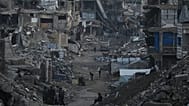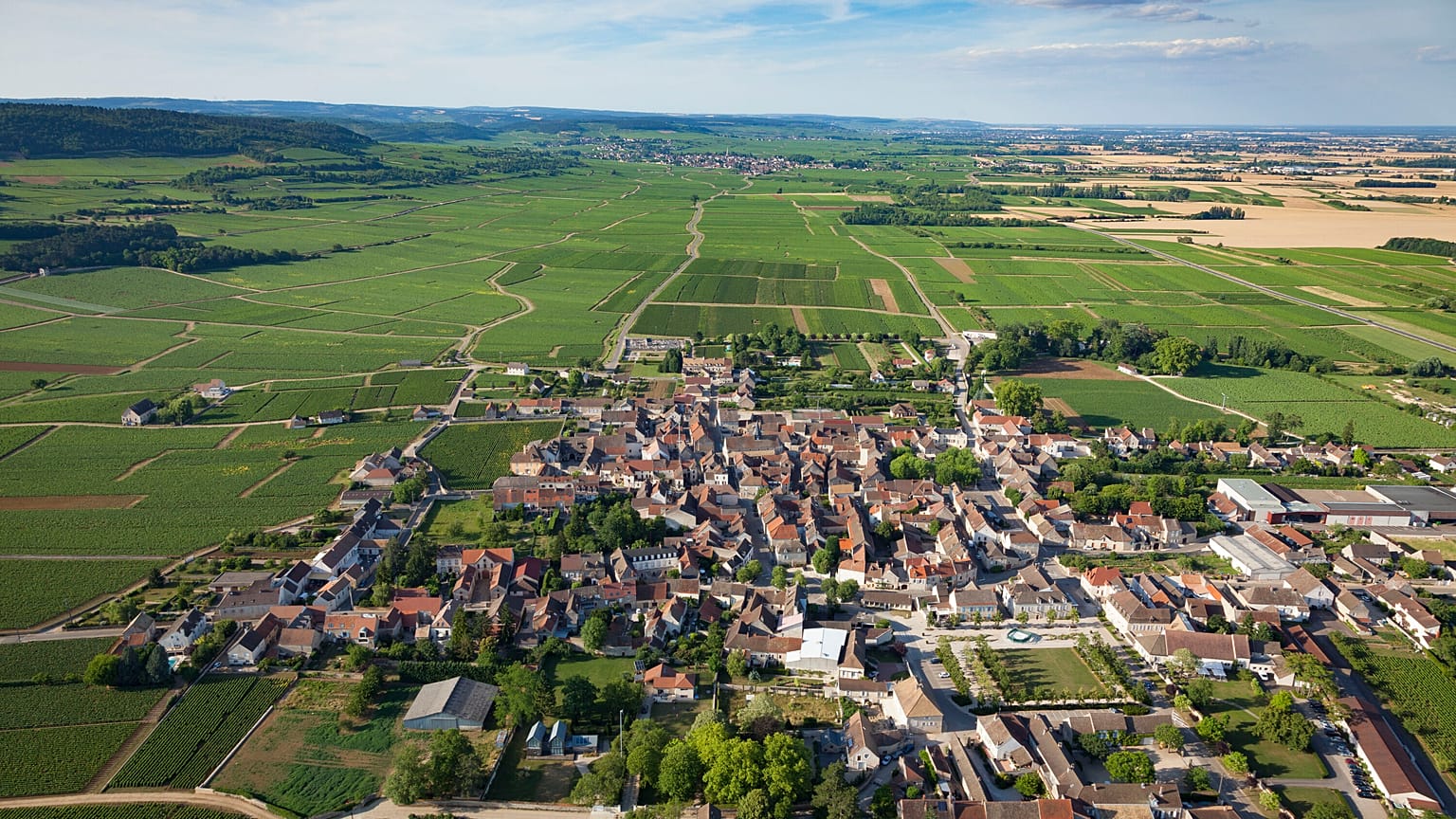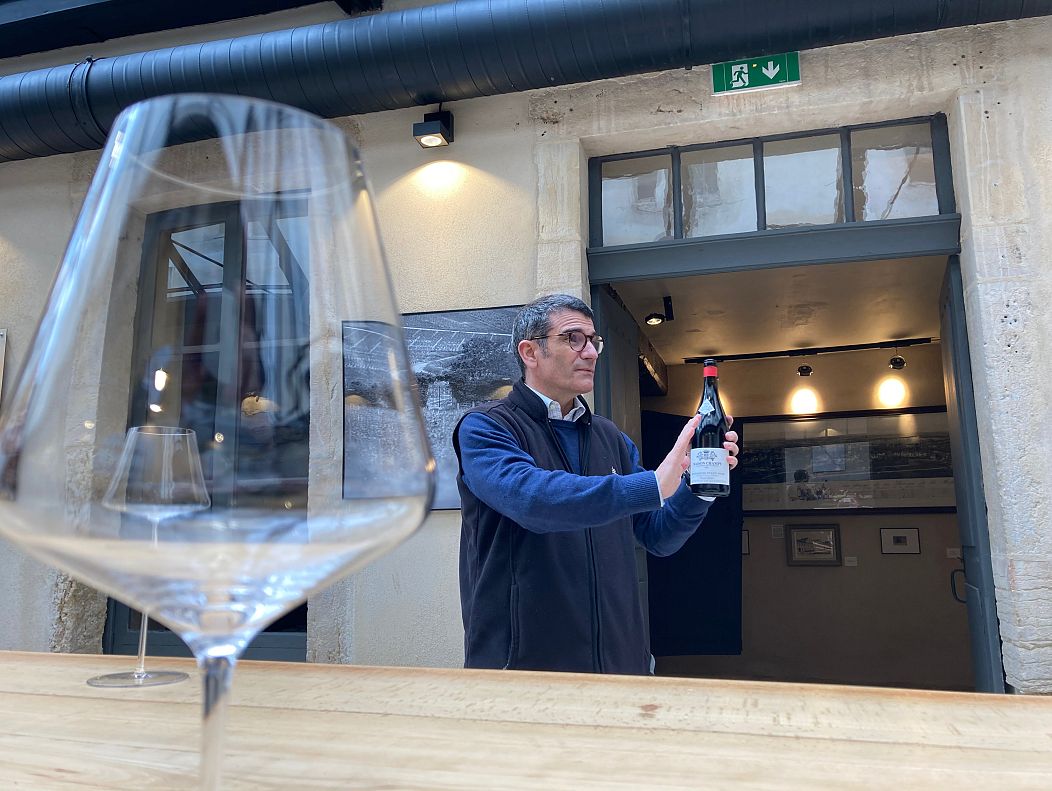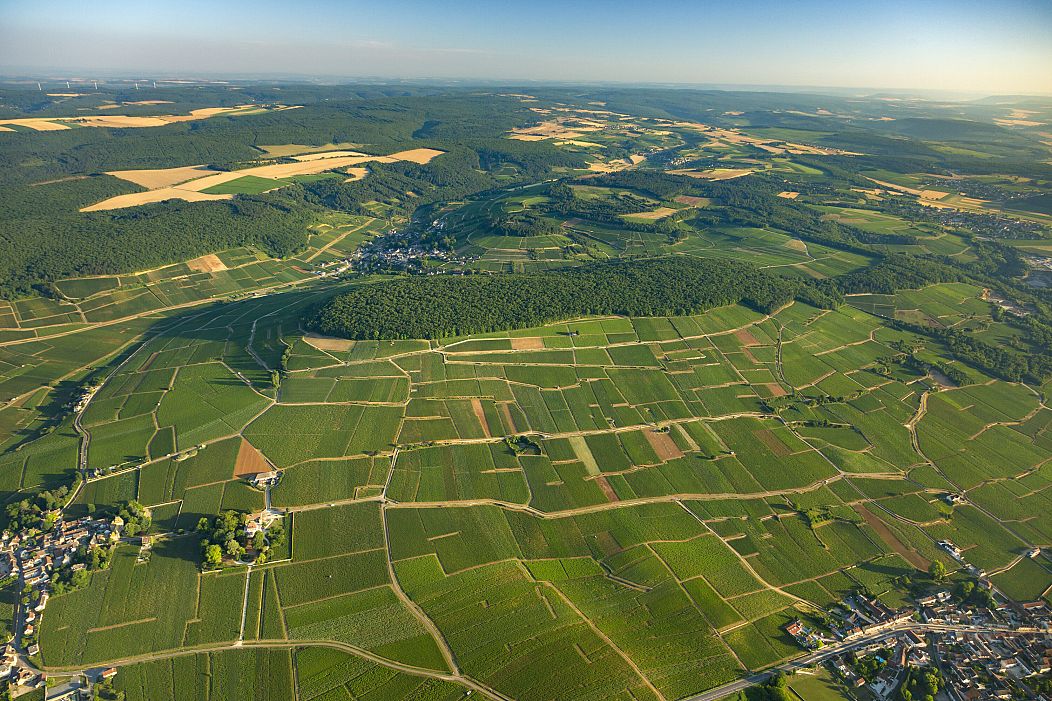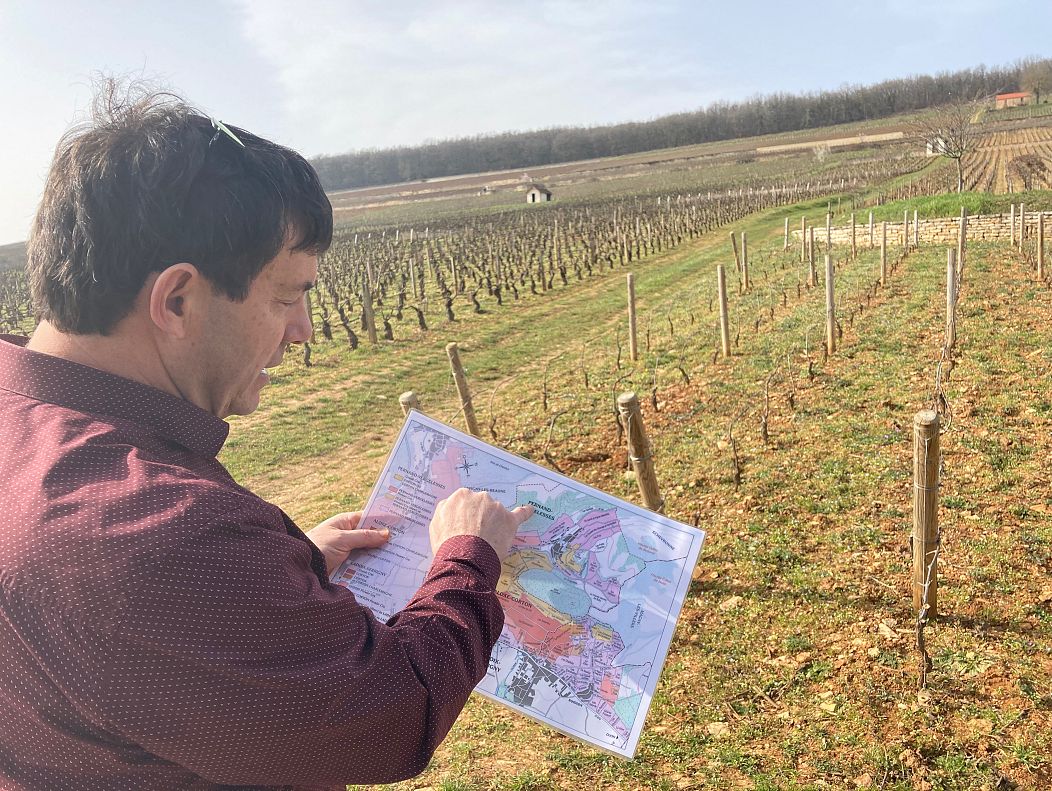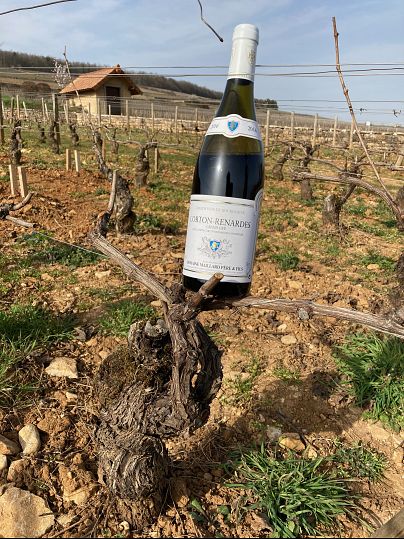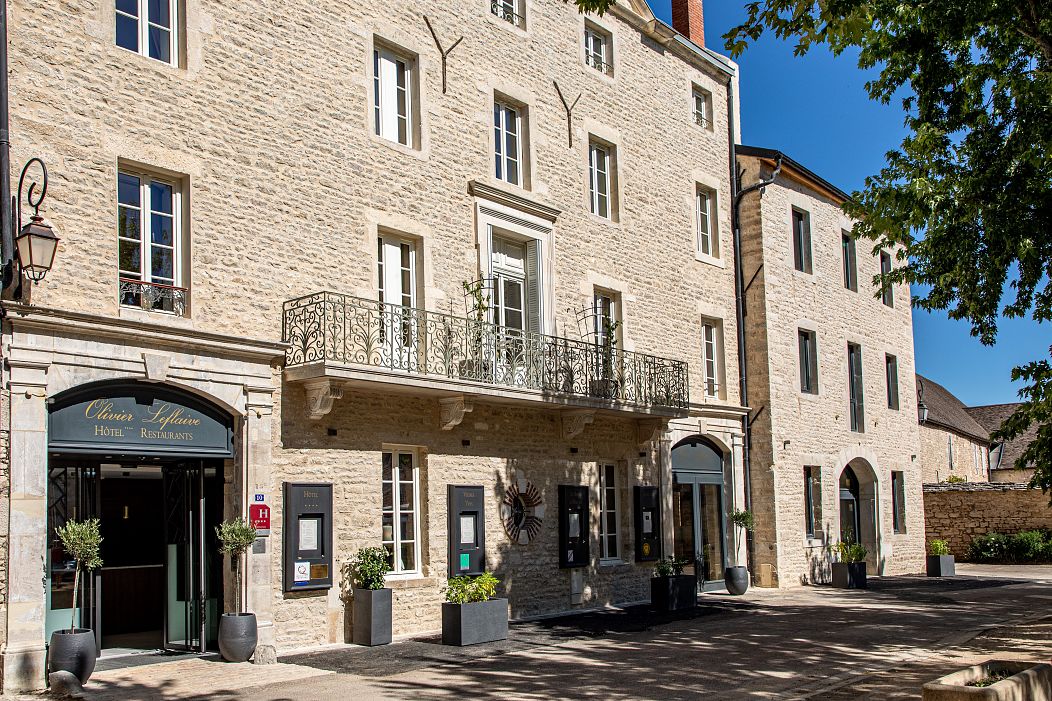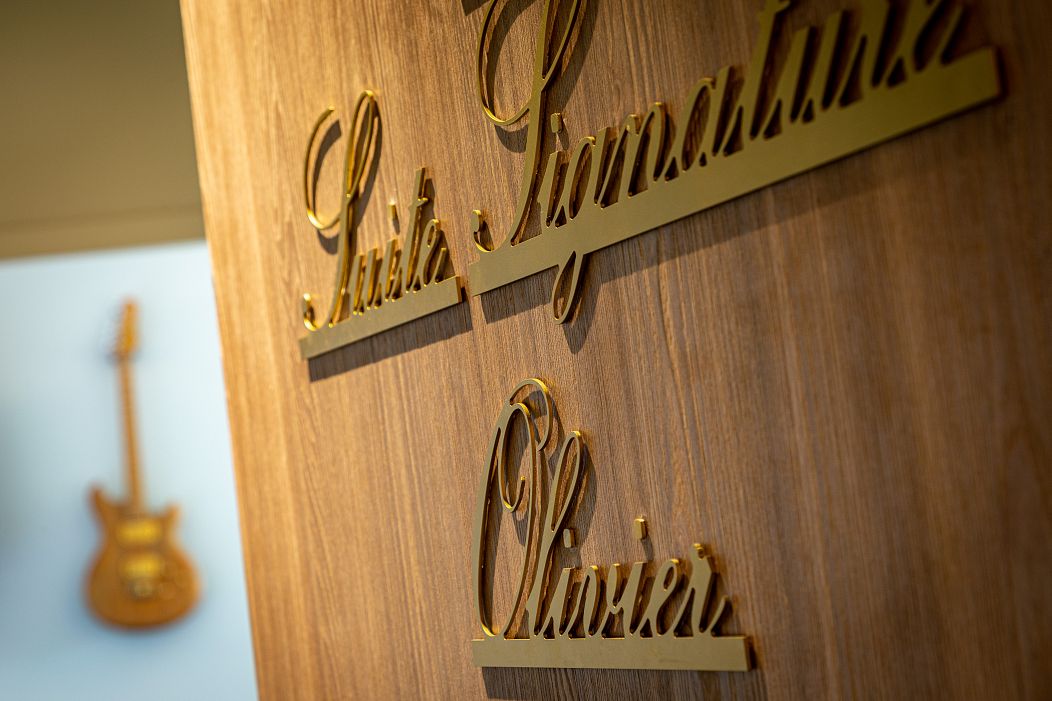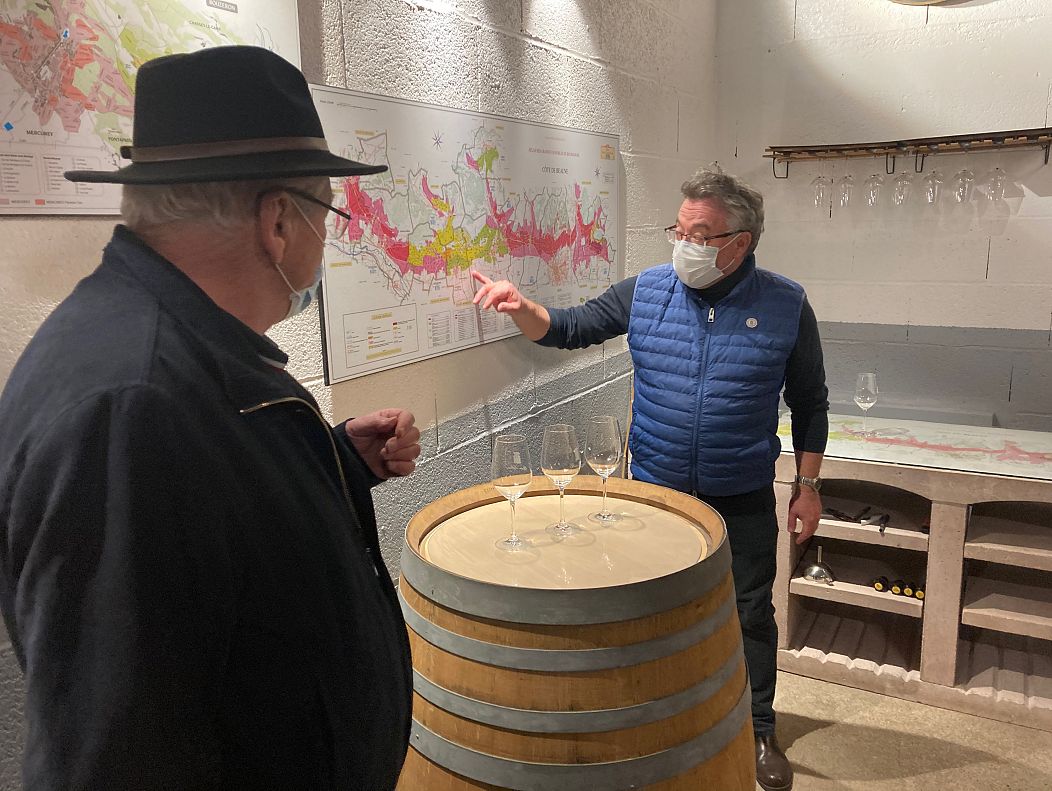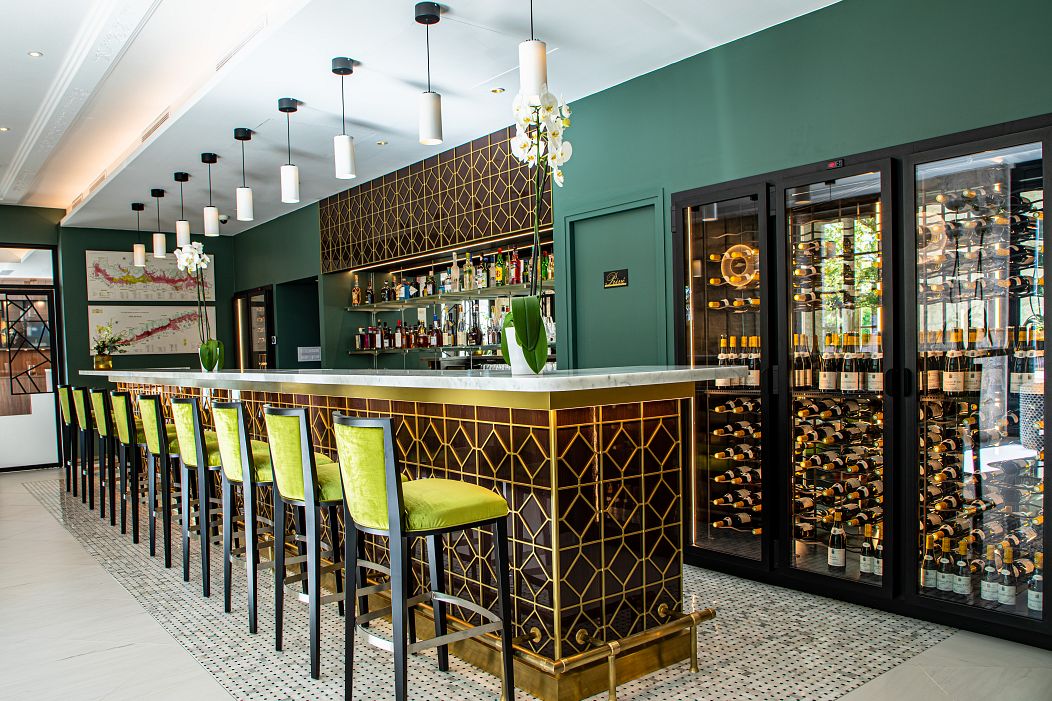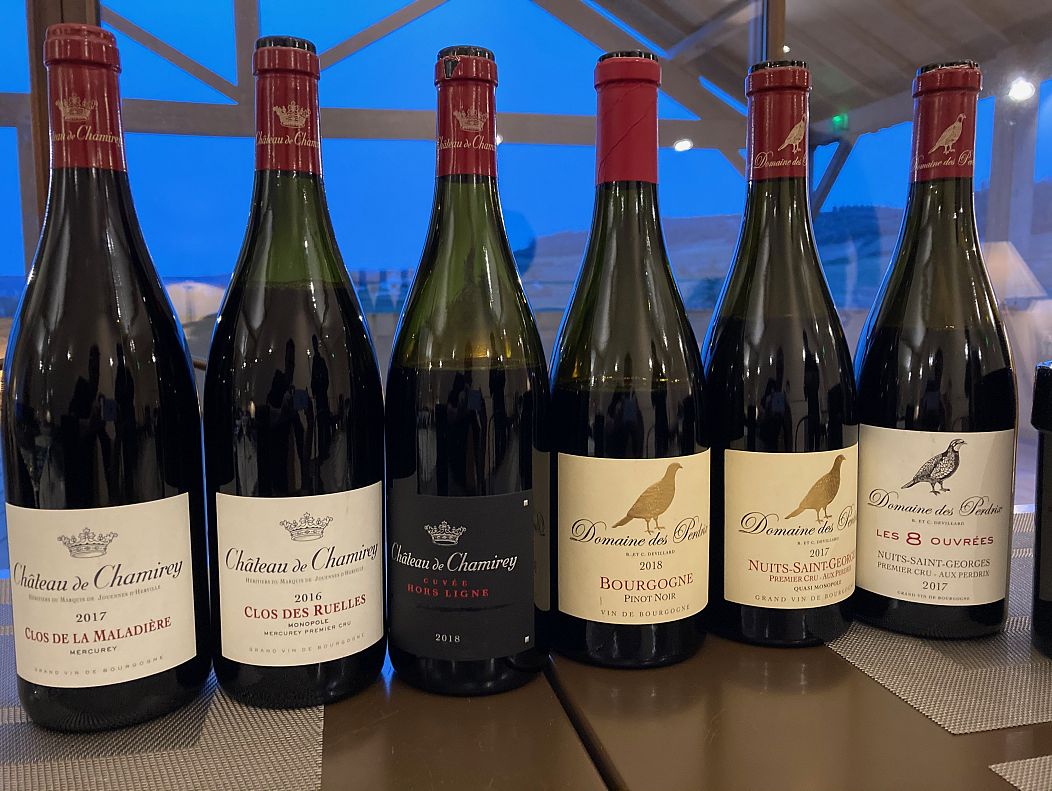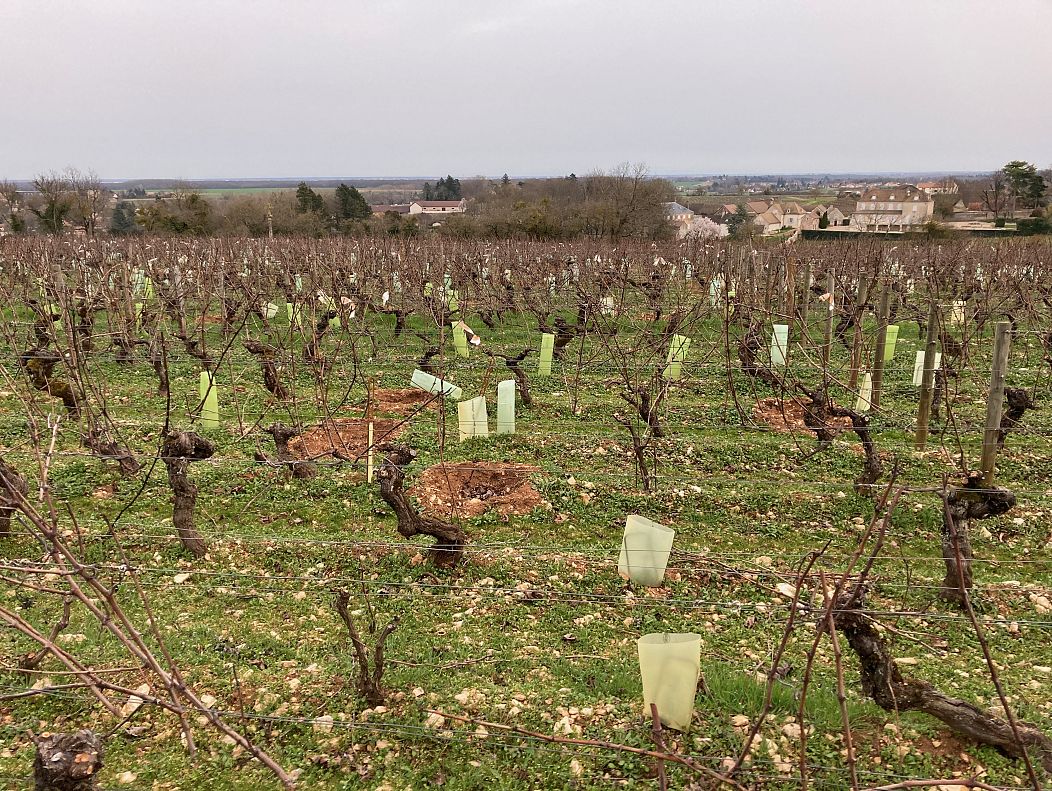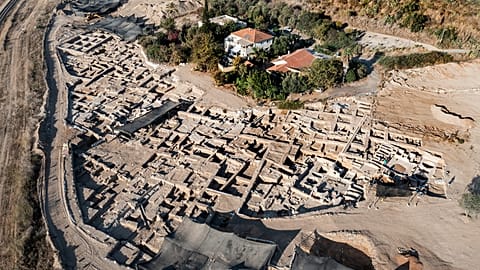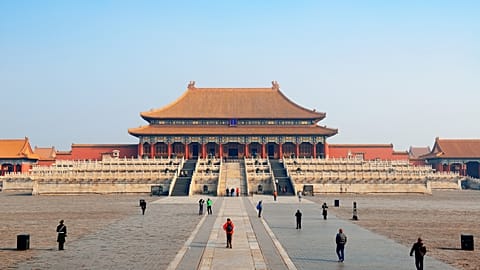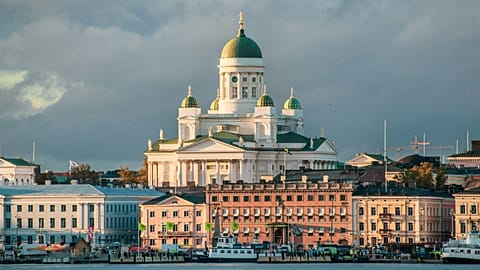Burgundy is an enigma. And the only way to truly understand it is to go there. Unwrap the puzzle and uncork the wine as Euronews takes you on the first of a series of wine adventures.
"We're going to do wine tasting the Burgundy way," says Dimitri. "Red's first!"
This is an outrage, I thought. But it turns out that there's method in it.
In the tasting room at the heritage-filled Maison Champy in Beaune, I am persuaded that finishing with whites clears one's palate and gives you renewed energy. I'm not about to argue.
As an introduction to Bourgogne (that's the word used when talking about the wines of Burgundy - and they might tell you off if you don't get the hang of it pretty quickly), a visit to this vinopolis is well worth your time. Not only do they make wine there, they also provide tastings, lunch and a history of the region, indeed in February 2021 they were awarded the Entreprise du Patrimoine Vivant which recognises a commitment to preserving a living heritage.
The tour focuses on how the brokers of Burgundy (sorry, Bourgogne) made their fortune and told the world about what is now the most celebrated Chardonnay and Pinot Noir on the planet.
The demand for wines grown on this very particular soil has escalated beyond reason.
Consequently, this thin strip of land, spanning 250 kilometres, has become the most expensive site for real estate in the world. Just over 30,000 hectares make around 205 million bottles, and more than half of those are exported - the US and the UK taking the largest portions.
Bourgogne wines encompass various sub-regions, from Chablis in the north to the Maconnais in the south that border Beaujolais. The most celebrated reds (made with Pinot Noir) are in the Cote de Nuits which begins just south of the picturesque city of Dijon. The world-beating whites come from the next sub-region on the road south - the Cote de Beaune.
Dimitri Bazas, who heads up the winemaking team at Maison Champy, is originally from Greece but has built his life here in Beaune. He takes me through a selection of wines from different terroirs and explains how the character can differ from plot to plot due to a series of both natural and human factors, from the aspect of the vineyard to the temperature of the fermentation - but the key factor is what lies beneath those vines.
I am shown maps of the myriad plots of land that jigsaw the hills and plateaus of this slice of Bourgogne. Vines only a few metres apart will make wines that are possessed of different characters. Not only that, the wines are also categorised in four sections. Regional, Villages, Premier Cru and Grand Cru.
To understand what, to many, seems like an enigmatic appellation system, you may need to avail yourself of a little training. Luckily, help is at hand in the form of the Ecole des Vins. You can pop in for a taster course or sign up for a 12-day masterclass, or if you want to be more hands-on, they can arrange for vineyard visits all across the region. They operate as a one-stop-shop for oenotourism, so whether you are desirous of a hot-air balloon view of these tesselating vinicultural rectangles or a month-long wine odyssey all across France, these guys can make it happen, budget or luxury.
This wine school is only one facet of a much wider organisation: the BIVB - Bureau Interprofessionnel des Vins de Bourgogne, which also serves as a quality auditor for production houses in order to maintain standards across the 300 trading houses, 17 cooperative cellars and 3,949 wine estates of Bourgogne. This entails everything from checking the cleanliness of tasting glasses to providing technical support to the winemakers not only on their production lines but also as a progressive business, able to market itself to 21st-century customers.
Stevie Bobes works with the BIVB to educate visitors wanting to understand more about Bourgogne terroir. A native Californian who has made France his home for more than half of his life, Stevie takes me to the village of Aloxe-Corton for a 'land reading'.
Perhaps the most joyous experience is being able to drink a bottle of wine made from grapes grown where you are standing. Stevie drives me up to the mid-slope of the hill and parks up. In the boot of his car is a cool box holding a bottle of Corton-Renardes Grand Cru 2016.
It is warm for early March. It's almost time for budburst, that exciting first sign of the growing season. It tends to occur between March and April when the average daily air temperature has consistently exceeded 10 degrees Celsius. As the wine is poured in all its semi-translucent, bright purple regality, I check the temperature. 14 degrees. Some call this 'fool's spring', as it can often precede a vast drop in temperature in March or even April where nighttime frosts can kill the buds that began their life thanks to the false dawn early in the year. It's not uncommon to hear stories of great swathes of a winegrower's vineyard being lost to damage from the elements. And 2021 has proved no exception. Early April frosts have led to bonfires all across winemaking France, and there is still great danger that huge amounts of crops will be lost.
But back in the sunny vineyard, this delectable Grand Cru saturates my palate with red fruit-imbued earth and spice. This will probably set you back between 80 and 100 euros if you can find one to purchase. The winemakers - Domaine Maillard Pere et Fils - suggest you pair it with "woodcock or wild boar", but if that seems a little ostentatious, I can assure you that it goes very nicely with conversation and very little else.
No expense spared
Many people balk at the prices. It's normal. But that was a Grand Cru, remember. They are at the top of the tree. You have Premier Cru, Villages and Regional wines to choose from too.
The price drops, fear not. But since you're interested in just how much people have spent...
Just up the road in the Cote de Nuits lies the village of Vosne-Romanee. Here you will find a pilgrimage site for wine obsessives worldwide in the guise of the Domaine Romanee-Conti. You will find people waxing lyrical about hallowed soils and perfection so perhaps it's not surprising (no, it is, it really is surprising) that one (ONE!) bottle of the extremely rare 1945 vintage fetched $558,000 at auction in the US in 2018.
If it's expensive Chardonnay you're after, make yourself at home with the name Leflaive.
Sorry mate, I'm cancelling your gig...
Olivier Leflaive sits down on a leather couch in his Vignes Vins Hotel in Puligny-Montrachet and takes off the hat that people fixate over for some reason. The businesses in which he holds shares make some of the world's finest Chardonnays and he has a claim to starting oenotourism in the area.
But what he really wants to talk about is music.
"I decided at a very young age to be a musician. I wanted to be a singer," Olivier says. He was playing high society, black tie, balls three nights a week, at the age of 19. "We were playing English and American Rock at these parties in Paris."
He clearly had a business head even then, for when he had to return to Reims for his studies, he decided to organise replacement bands for these gigs and manage the bands himself. And it's a good job he had that sense since his father cut him off financially for having the temerity to seek his fortune in the world of popular music. "Artists are very disgusting," he says, impersonating his father, "they smoke hashish and use cocaine..."
A few years later, Olivier is married and had completed his stint in the army. He gives Paris another shot.
"We worked four restaurants outside Notre Dame. Every night we played 10-15 mins as buskers for two years. I played a 12-string Martin guitar and my wife played a South American flute. We didn't sing, because people were fed up with all that."
At about this time, Olivier Leflaive gets a reality check.
"There was a school of music in Paris, curated by an elderly woman who had been a famous singer in her time. At this school there was a system where people would come and present a song which, if deemed good enough, would get onto television.
"One day the old lady said to my wife: 'Olivier, your husband, is complete crap, but you are pretty and you sing very well.' So I proposed that my wife joined a group of four girls, who then toured the world, and I started giving guitar lessons."
He continued as something of an impresario for a while, putting on genre-specific gig nights where he would also book an opening act that was totally leftfield. Not only that, he introduced Paris to the concept of open cabaret. This went down a storm for three years in the late 70s. 1981-2 were difficult years for him. He was told the concept was not the way forward, despite the audiences suggesting otherwise; his wife left him; his father died. He was fed up and decided to return to Bourgogne.
"When my father died, nobody wanted to continue to work at the Domaine Leflaive. I was coming back often, for the harvest, for the tasting. My Uncle, Vincent, asked me to co-manage Domaine Leflaive."
One day he said to his family, "I am going to start my own business". The idea was not just to buy grapes from his village of Puligny-Montrachet but to make wine from all over the Cote de Beaune.
His family was not, he says, forthcoming with a great deal of financial support so he and his brother, Patrick have a majority share in the separate Domaine Olivier Leflaive, which launched on January 1st 1985.
His family tree begins flowering in 1635 and boasts several prominent winemakers. So there is that element of keeping everything close and sacred, enclosed within a family, within a tradition. But there is also an international flavour, something shared by all of the forward-thinking winemakers I have ever met. Those producers who have travelled, accepted other cultures, other working practices, are those whose vision seems to succeed. So Olivier sent his daughter, Julie, out into the import universe, to 'take the temperature of the market', to attempt to understand the industry and how the customer feels within that milieu. The 'joined-up thinking', as she puts it, of the New World informs her practices going forward and gives her a holistic goal for the family hotel.
"Values transmit better with a holistic vision," says Julie, as she opens the door to one of the quirky, appealing rooms in the Vignes Vins Hotel. Each one is named after a member of that family tree and features a potted biography of that family stalwart, framed within the room.
Double rooms are available here from 150 euros per night. Which family member will you enjoy?
Wines from all over the world are available in the stunning new bar and bistrot reflecting Julie and Olivier's world vision. In 1997, he built his concept of a lunch wine tasting. Instead of 'a cold tasting in a dark cellar', says Julie, her father decided to make the experience into a brightly-coloured lunch. "These people were parting with a lot of money. They deserve to be treated accordingly."
If you would like to be treated accordingly, they are opening for bookings on 2 April.
Amaury Devillard is another well-travelled winemaker with a broad vision.
It is reflected in the architecture of his tasting room, shop and table d'hote at Chateau de Chamirey in Mercurey, which is part of the Cote Chalonnais. Tall, wide glass panes. Transparent floor tiles to give a glimpse of the cellar. His is a philosophy that owes much to the aesthetes of the nineteenth century, particularly Walter Pater and his sometime disciple, Oscar Wilde.
Devillard is all about moments. He and his wife Pauline own land on five separate estates, all with their own unique character, and he sees each pixel of his produce as something to be savoured.
His ideas are in stark contrast to the days of his father's youth when local miners used to "drink between seven and ten litres of wine a day."
"The wines were seven to eight degrees of alcohol but they were being drunk for vitamins," says Amaury, opening a bottle of his Clos des Ruelles 2016. It's a 'monopole', which means a plot of land owned entirely by one owner. "We love monopole," he laughs. "You control the single expression." But there are more fun rules to enjoy here.
"In order to call it 'Clos' we need to have a minimum of three walls out of four." This is yet more evidence of the Bourgogne system that might be better looked at admiringly than completely understood.
But Devillard is someone always hungry to know more, and to that end, he has actually gone back to school. He shows me his student card - University de Bourgogne 2021 - then laments that the perk of cheap cinema tickets is pointless while everything is closed. Much like most student cards, the picture resembles that of a murderer, but it's genuine and he is studying Oenology. I am drinking his 2017 Mercurey Premier Cru 'La Mission'. I'm not sure how much more this guy needs to learn but I admire his modesty.
The bottle is perched on a slab of quarried rock that serves as a banquet table. The dusk is swiftly approaching and the spiky winter vines of the vineyard where the contents of my glass were born stretch out in front of me towards a line of hedgerows, then more vines, a house, fallow fields, and then the now-invisible Alps 250 kilometres away.
Little tubes of plastic protect the newly planted and grafted vines that will one day look as gnarled as their neighbours, encapsulating within a single glance the full circle of life and death as the wood begins to wake from winter, and budburst is only days away.
"Moments," Devillard says.

